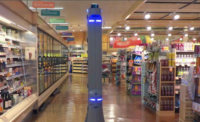The value of the global food automation industry is expected to increase to $2.5 billion by 2022, mimicking similar growth in the confectionery market, according to Markets and Markets.
With a projected value of over $232 million by 2022 — up from more than $184 million in 2015 — several factors continue to propel the confectionery industry’s expansion. These include continued product innovation and diversification, a rise in gifting trends, an increase in discretionary spending in emerging markets and even retail market expansion, according to a Market Watch report. Perhaps most importantly, evolving consumer demands prompt confectionery manufacturers to vary their product ranges, including more unique, exotic and natural options. As a result, these companies must squeeze as much efficiency and flexibility out of their lines as possible.
Enter robotics. While short runs and small batch production are not necessarily new to confectioners, the methodology is increasingly shifting from manual to automated operations. Robots and collaborative robots, or cobots, can precisely pick, sort, place, pack and palletize products like chocolates at high speeds, allowing confectionery brands to evolve their practices to meet demand without sacrificing efficiency.
Taking on new roles
Robotics have existed in the confectionery space, having been utilized in primary, secondary and tertiary packaging for several years.
However, applications are growing in inspection and sorting ahead of the packaging line. The robot’s precision is necessary when handling shaped product, such as teddy bear cut chocolates. Typically situated in a random pattern on the conveyor, shaped product needs twisting and orienting by a robot to fit in molds in the proper pattern and without breaking — a task robots complete at very high speeds. From a processing perspective, delta robots with cameras can be used to remove pieces that are not fully/properly formed or enrobed, ensuring they never reach the consumer and result in a complaint. These robots also play an important role in rejecting stacked or connected pieces to prevent a back-up on the packaging line.
Catalysts for improvement
As robotics technology improves, it becomes more transformative to confectionery manufacturing.
For example, the use of cobots, which are designed with the sensory capabilities to halt or slow an action amid an obstacle or interference, can augment human labor without the need for large cages or guards. This makes for a safer environment for workers and helps companies minimize their factory footprints.
Additionally, labor can be reassigned to tasks that are less redundant and physically stressful to humans, who can suffer musculoskeletal injuries from repetitive tasks.
With the increased sorting and inspection capabilities of robots, brands also benefit from only seeing properly processed product in the package.
In addition, leveraging the dexterity and learning capabilities of robots can allow for more product in the first and secondary package, which minimizes product waste.
Looking toward the future, high connectivity with mass data analysis will improve efficiency and make operations more dynamic in real time. In addition, ancillary systems such as vision systems or artificial intelligence may be added in conjunction with robotics to boost productivity and efficiency even further.
Find the Latest Innovations at ProFood Tech
Confectionery manufacturers seeking technologies to improve product quality, worker safety and efficiency can find solutions for processing lines at ProFood Tech 2019 (March 26–28, 2019; McCormick Place, Chicago).
The show is the only event in North America focused exclusively on all food and beverage sectors, featuring 7,000 processing professionals and 400 of the world’s top suppliers showcasing new innovations on over 125,000 net sq. ft. of exhibit floor. Registration for ProFood Tech is $30 until March 1, after which the price increases to $100. For more information and to register online, visit www.profoodtech.com.






